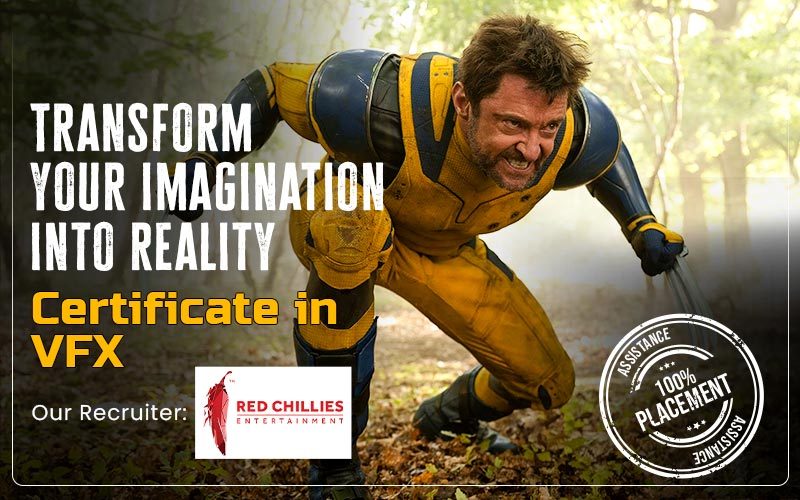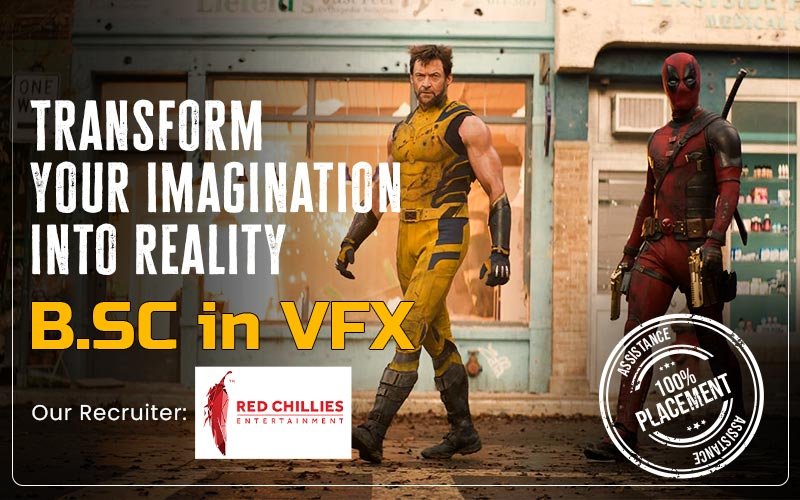When it comes to superhero films, visual effects (VFX) play a pivotal role in bringing larger-than-life characters and action-packed sequences to the screen. Two of the most beloved and iconic characters in the Marvel universe, Deadpool and Wolverine, owe much of their cinematic success to the extraordinary VFX work that breathes life into their extraordinary abilities and epic battles. VFX enthusiasts and students of VFX and animation courses are waiting for this new release.
The VFX artistry behind these two fan-favorite heroes and explore how technology has enhanced their storytelling.
The Merc with a Mouth: Deadpool
Character Design and Motion Capture:
- Facial Expressions: Deadpool’s mask, which covers his entire face, is uniquely animated to reflect his exaggerated expressions. This requires advanced motion capture technology to translate actor Ryan Reynolds’ performance into the character’s mask movements seamlessly.
- Body Movements: The character’s agility and combat skills are enhanced through motion capture, allowing for fluid and dynamic fight scenes that stay true to Deadpool’s comic book origins.
Healing Factor:
- Regeneration Scenes: Deadpool’s healing factor is a signature ability, and depicting it on screen involves complex VFX work. From regenerating limbs to healing from severe wounds, these scenes require meticulous digital compositing and CGI to ensure they look realistic yet fantastical. It is interestingly one of the key topics taught at many VFX training courses.
Action Sequences:
- Stunt Coordination and VFX Integration: Deadpool’s over-the-top action sequences, filled with acrobatics and explosions, combine practical stunts with VFX. Stunt performances are often enhanced with CGI to amplify the action, making scenes more visually striking.
- Bullet Time Effects: Inspired by “The Matrix,” Deadpool often features slow-motion bullet-dodging scenes. These are crafted using a combination of live-action footage and VFX, creating a dramatic and visually stunning effect.
Breaking the Fourth Wall:
- Meta Visuals: Deadpool’s unique ability to break the fourth wall and directly address the audience is complemented by creative VFX. Text overlays, pop-up graphics, and other visual cues are used to enhance his meta-commentary, making these moments more engaging and humorous.
The Adamantium-Claw Wolverine

Claw Effects:
- CGI Claws: Wolverine’s iconic adamantium claws are primarily created using CGI. This allows for precise control over their appearance, movements, and interactions with the environment. Practical effects are occasionally used for close-up shots, but CGI ensures seamless integration during action scenes. A couple of VFX institutes have done some interesting research on this too.
- Claw Retraction and Extension: The process of Wolverine’s claws extending and retracting is a signature visual effect. Detailed CGI work ensures this transformation looks natural and believable, emphasizing the character’s raw power.
Healing Factor:
- Realistic Regeneration: Similar to Deadpool, Wolverine’s healing factor is a crucial aspect of his character. Depicting his wounds healing in real-time involves sophisticated VFX to create a seamless and realistic effect, whether it’s healing from bullet wounds or regenerating tissue.
Superhuman Strength and Agility:
- Enhanced Combat Scenes: Wolverine’s intense combat scenes require a blend of practical stunts and CGI. His superhuman strength and agility are exaggerated with VFX, making his fights more impactful and visually thrilling.
- Animalistic Movements: Wolverine’s feral nature is reflected in his movements. Motion capture and CGI are used to enhance his animalistic fighting style, showcasing his primal rage and physical prowess.
Environment and Interaction:
- Destructive Power: Wolverine’s battles often result in significant destruction, from slashing through walls to toppling vehicles. These scenes involve detailed VFX work to simulate realistic interactions between Wolverine and his environment, ensuring the destruction looks authentic.
- Integration with Practical Effects: Practical effects like pyrotechnics and wirework are combined with CGI to create more immersive action sequences. This hybrid approach enhances the realism and intensity of Wolverine’s on-screen battles.
Collaborative Effort: VFX and Filmmaking
The VFX work behind Deadpool and Wolverine is a testament to the collaborative efforts between directors, actors, stunt coordinators, and visual effects artists. Each department plays a crucial role in bringing these characters to life:
- Directors: Visionaries who conceptualize the scenes and guide the overall aesthetic.
- Actors: Performances captured through motion capture and live-action footage, providing the foundation for CGI enhancements.
- Stunt Coordinators: Design and execute complex stunts, which are then augmented with VFX.
- VFX Artists: Craft the digital magic that transforms raw footage into spectacular scenes, using tools like CGI, digital compositing, and motion capture technology.
Conclusion
The visual effects behind Deadpool and Wolverine are nothing short of cinematic magic. They transform comic book fantasies into on-screen realities, creating unforgettable experiences for audiences. Through the masterful use of CGI, motion capture, and practical effects, these characters are brought to life in ways that honor their comic book origins while pushing the boundaries of modern filmmaking. As technology continues to advance, the future holds even more exciting possibilities for the VFX of our favorite superheroes, promising ever more thrilling and visually stunning adventures.

